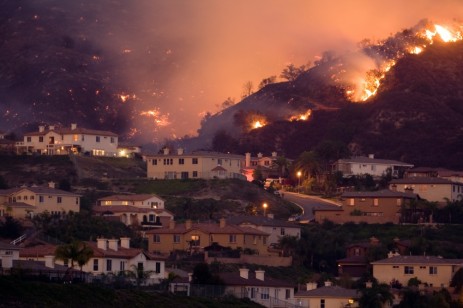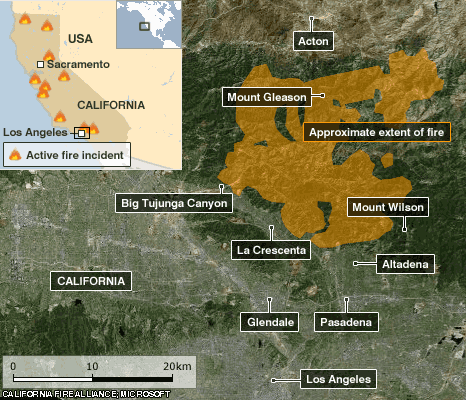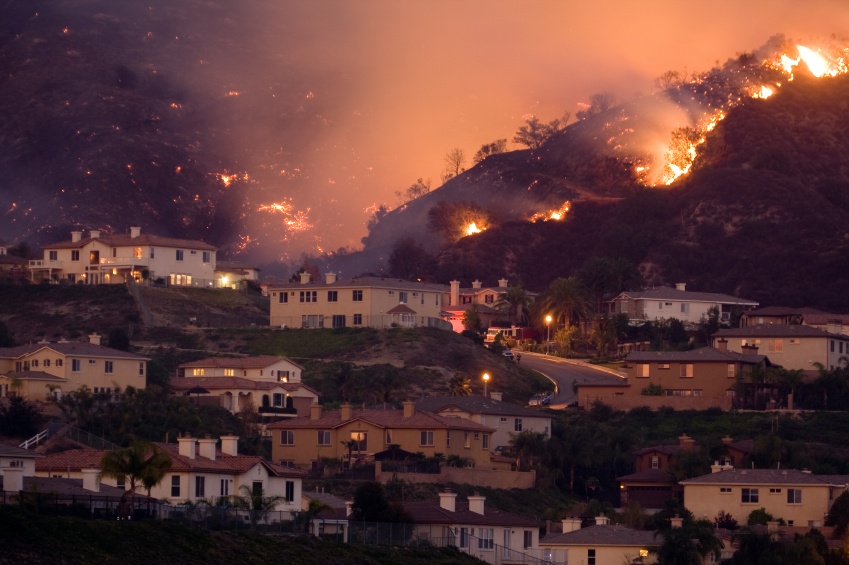 The scientific literature paints a hellish future if we don’t quickly reverse greenhouse gas emissions trends (see “Climate change expected to sharply increase Western wildfire burn area — as much as 175% by the 2050s“). Even the watered down, consensus-based 2007 IPCC report acknowledged the danger:
The scientific literature paints a hellish future if we don’t quickly reverse greenhouse gas emissions trends (see “Climate change expected to sharply increase Western wildfire burn area — as much as 175% by the 2050s“). Even the watered down, consensus-based 2007 IPCC report acknowledged the danger:
A warming climate encourages wildfires through a longer summer period that dries fuels, promoting easier ignition and faster spread. Westerling et al. (2006 — see here) found that, in the last three decades, the wildfire season in the western U.S. has increased by 78 days, and burn durations of fires >1000 ha have increased from 7.5 to 37.1 days, in response to a spring-summer warming of 0.87°C. Earlier spring snowmelt has led to longer growing seasons and drought, especially at higher elevations, where the increase in wildfire activity has been greatest. In the south-western U.S., fire activity is correlated with ENSO positive phases, and higher Palmer Drought Severity Indices….
Insects and diseases are a natural part of ecosystems. In forests, periodic insect epidemics kill trees over large regions, providing dead, desiccated fuels for large wildfires. These epidemics are related to aspects of insect life cycles that are climate sensitive.
Now brutal heat and drought are fueling massive California wildfires once again (see, for instance, the BBC piece “Heat fuelling California wildfire“). We can’t expect much from the status quo media (see “CNN, ABC, WashPost, and AP blow Australian wildfire, drought, heat-wave story“). So here is CAP’s Tom Kenworthy explaining “What a 1-Degree Temperature Increase Means for Wildfires” — and I’ll end with some comments on this positive or amplifying carbon-cycle feedback:

To the average person a 1-degree rise in average spring and summer temperatures may not seem like much. But for residents of the western United States — including California, which is fighting at least eight fires right now — it could mean a staggering increase in the extent and cost of fires according to a recent study.
In their report, researchers at Headwaters Economics, an independent nonprofit research group in Bozeman, Mont., predict that climate change and the accelerating movement of western residents to areas near or in undeveloped forests will likely prove to be a devastating combination. That 1-degree increase in spring and summer temperatures, they conclude, will increase the area burned by seasonal fires in Montana by more than 300 percent and more than double the cost of protecting homes threatened by fire.
Though the Headwaters paper focuses on Montana, using data from 18 large fires in the state during 2006 and 2007, it has implications for fire-prone areas throughout the Rocky Mountain West. And it builds on a growing body of evidence that inaction on climate change will cost the western United States dearly.
Earlier this summer, for example, Harvard University scientists published a study in the Journal of Geophysical Research predicting that areas burned by wildfires in the West could increase by 50 percent by 2050, with even larger increases of 75 percent to 175 percent in the Pacific Northwest and Rocky Mountain West. Those increases could have “large impacts on human health” because of the added smoke and particulates released into the air, the study said.
Federal and state agencies responsible for fighting western wildfires, particularly the United States Forest Service, are already struggling to cope with the rapidly increasing costs of protecting lives and property. Since 2000, wildland fires in the United States have burned an average of more than 7 million acres a year, about double the average acreage for the previous four decades.
Federal firefighting costs have also risen dramatically, according to the Government Accountability Office, averaging $2.9 billion per year from fiscal 2001-2005 compared to $1.1 billion in the previous five-year period.
The Headwaters study predicts that state wildland firefighting costs in Montana will double to quadruple by 2025.
The increasing popularity of building homes in or near forested areas, known as the wildland-urban interface, or WUI, is a major factor in the escalating costs of fire suppression. A 2006 report by the Department of Agriculture’s Office of Inspector General found that “the majority of [Forest Service] large fire suppression costs are directly linked to protecting private property in the WUI,” with Forest Service managers estimating between 50 and 95 percent of large fire costs spent on that purpose alone. Though federal agencies shoulder the major financial burden for protecting those homes, development decisions in wild areas are made by local and state officials.
“While fire-prone lands are being developed, the climate is warming, leading to more large fires,” write the authors of the Headwaters Economics report, which notes that with just 14 percent of the wildland urban interface developed in the West, the cost of protecting those areas will increase significantly. “More development in these sensitive areas would lead to more wildfire suppression costs, even in the absence of climate change. Climate change will only exacerbate this effect.”
Climate change and its impacts on temperature, drought, and snowpack runoff will affect fires as well as many other aspects of life in the West.
Climate models predict that global warming will significantly reduce snow runoff in the West, the region’s major source of water. A study published in April by the Scripps Institution of Oceanography estimated that the Colorado River, the lifeline for 27 million people in the Southwest, will not be able to produce its allocated water supply 60 percent to 90 percent of the time by mid-century. That would have major impacts on food production, recreation, and development in the fastest-growing region in the nation. It will also mean forests will dry out sooner, with a likely increase in fire activity.
And in recent years, a widespread and so far unchecked epidemic of mountain pine beetles that has killed millions of acres of trees from Colorado north into Canada has laid the foundation for a potentially large increase in catastrophic fires. Climate change has played a role in that outbreak, too, as warmer winters spare the beetles from low temperatures that would normally kill them off, and drought stresses trees.
In the western United States, mountain pine beetles have killed some 6.5 million acres of forest, according to the Associated Press. As large as that path of destruction is, it’s dwarfed by the 35 million acres killed in British Columbia, which has experienced a rash of forest fires this summer that as of early this month had burned more than 155,000 acres. In the United States to date about 5.2 million acres — an area larger than Massachusetts — have burned this year.
Destruction of trees by the mountain pine beetle, combined with climate change and fire, makes for a dangerous feedback loop. Dead forests sequester less carbon dioxide. Burning forests release lots of carbon dioxide into the atmosphere. More carbon dioxide adds to climate change, which raises temperatures, stresses forests, and makes more and bigger fires more likely.
It’s a frightening prospect, as British Columbia’s Forests Minister Pat Bell told an International Energy Agency conference last week. “I am not a doomsayer,” said Bell. “I am not one who wants to say we are beyond the tipping point. But I am afraid that we are getting close to that.”
The final reason to worry about the climate-wildfire connection is that wildfires are a classic amplifying feedback, since burning forests release carbon dioxide that accelerates global warming. As the 2006 Science article, “Warming and Earlier Spring Increase Western U.S. Forest Wildfire Activity” (subs. req’d), concludes soberly:
… virtually all climate-model projections indicate that warmer springs and summers will occur over the region in coming decades. These trends will reinforce the tendency toward early spring snowmelt and longer fire seasons. This will accentuate conditions favorable to the occurrence of large wildfires, amplifying the vulnerability the region has experienced since the mid-1980s. The Intergovernmental Panel on Climate Change’s consensus range of 1.5° to 5.8°C projected global surface temperature warming by the end of the 21st century is considerably larger than the recent warming of less than 0.9°C observed in spring and summer during recent decades over the western region.
If the average length and intensity of summer drought increases in the Northern Rockies and mountains elsewhere in the western United States, an increased frequency of large wildfires will lead to changes in forest composition and reduced tree densities, thus affecting carbon pools. Current estimates indicate that western U.S. forests are responsible for 20 to 40% of total U.S. carbon sequestration. If wildfire trends continue, at least initially, this biomass burning will result in carbon release, suggesting that the forests of the western United States may become a source of increased atmospheric carbon dioxide rather than a sink, even under a relatively modest temperature-increase scenario. Moreover, a recent study has shown that warmer, longer growing seasons lead to reduced CO2 uptake in high-elevation forests, particularly during droughts. Hence, the projected regional warming and consequent increase in wildfire activity in the western United States is likely to magnify the threats to human communities and ecosystems, and substantially increase the management challenges in restoring forests and reducing greenhouse gas emissions.
We are simply running out of time to stop all of the carbon-cycle feedbacks from intensifying and to stop these devastating, record-breaking wildfires from becoming the normal climate.


